#orbital structure estimating
Explore tagged Tumblr posts
Text
Beyond Earth | The Role of a Construction Cost Estimating Service in Lunar and Space Habitat Projects
Introduction
As humanity expands its reach beyond Earth, construction is no longer confined to terrestrial landscapes. Ambitious plans from space agencies and private firms alike aim to establish permanent habitats on the Moon and even Mars. While the science behind these missions often takes the spotlight, one fundamental challenge remains critical: budgeting. In this futuristic context, a construction cost estimating service becomes as vital as propulsion systems and life support. Estimating construction costs for lunar habitats is an emerging discipline, bridging engineering, logistics, and economics in an entirely new domain.
The Challenges of Off-Earth Construction
Unlike conventional building environments, lunar and space habitats face extreme constraints. Materials must survive radiation, microgravity, and vacuum conditions. Transporting building supplies from Earth is immensely expensive, with every kilogram costing thousands of dollars. Labor is automated or conducted by astronauts under high-risk conditions, making precision in planning and budgeting non-negotiable.
Traditional construction cost estimating services cannot simply extend their models to space without modification. New frameworks must address entirely different metrics—launch mass, fabrication in zero gravity, and material behavior in non-Earth atmospheres.
Reimagining Cost Inputs in Space Projects
In terrestrial construction, estimators consider land acquisition, local labor rates, and weather impacts. In space, the variables are starkly different. A specialized construction cost estimating service must adapt to factors such as:
Launch weight penalties: Every extra kilogram impacts rocket fuel costs. Estimators must calculate mass-efficient solutions and include cost-benefit analyses for lighter or in-situ materials.
In-situ resource utilization (ISRU): Using lunar regolith or Martian soil to build structures cuts down transport costs. Estimators must model these savings accurately.
Automation and robotics: Much of space construction will rely on robotic systems. Estimating the cost of custom hardware, maintenance, and redundancy becomes crucial.
Habitat resilience: Structures must withstand radiation, micrometeorites, and thermal extremes. These safety requirements inflate material and engineering costs, demanding specialized forecasting.
Material Considerations and Transport Costs
Earth-based construction has access to a broad array of materials, suppliers, and delivery options. For lunar or Martian projects, the first cost hurdle is transport. A construction cost estimating service operating in this context must begin by assessing:
The cost of launching construction components via existing heavy-lift vehicles
The modular breakdown of prefabricated structures to fit within payload constraints
Opportunities to 3D-print using local materials, which introduces cost advantages but also new maintenance and reliability factors
These estimators must also calculate the cost implications of redundancy. In space, failure is not an option—spare parts and fail-safes must be factored into every budget.
Design and Engineering Collaboration
Close collaboration between cost estimators and aerospace engineers is essential. Every design decision affects cost exponentially. For example, selecting a spherical habitat design for its structural efficiency in resisting external pressure may reduce material volume but increase fabrication complexity.
A construction cost estimating service can simulate different design choices and their cost trajectories under space conditions. This collaborative feedback loop is essential for mission planners aiming to balance safety, performance, and financial feasibility.
Examples from Current Space Programs
NASA’s Artemis program and private initiatives like SpaceX’s Starship project are rapidly advancing the potential for lunar bases. While public estimates exist for mission costs, the actual construction phase of lunar surface infrastructure remains largely theoretical.
However, testbeds such as the Mars Dune Alpha habitat—being built on Earth to simulate Martian conditions—already employ advanced cost estimation to determine long-term feasibility. These prototypes rely on construction cost estimating services that consider both Earth-based costs and extrapolated values for deployment beyond our atmosphere.
Predictive Modeling and Future-Proofing
Because space construction is largely untested, predictive modeling is crucial. Cost estimators use probabilistic modeling to account for unknowns: delays due to solar events, failure rates of equipment, or advances in propulsion that may alter transport costs.
As technology evolves, future cost estimates must also be adaptable. For instance, the development of reusable rockets or on-site robotic assembly could drastically reduce certain costs while introducing others. Construction cost estimating services must remain flexible and continuously update their models as aerospace capabilities advance.
Sustainability and Lifecycle Costing in Space
Even in the vacuum of space, sustainability matters. Space habitats must function autonomously for extended periods. Estimators must assess the full lifecycle costs of structures: how often components need replacement, what energy systems are most efficient, and how waste is managed.
Just as on Earth, lifecycle costing helps mission planners make sustainable, long-term decisions that reduce risk and optimize investment. For space projects, these estimations are even more critical due to the complexity of repair and maintenance operations in extreme environments.
Conclusion
As we push the boundaries of civilization into outer space, the disciplines of architecture and construction must evolve—and with them, the role of cost estimation. A construction cost estimating service tailored to lunar and space habitats isn't just a support function; it's a foundation for feasibility, safety, and sustainability. By integrating mass constraints, ISRU, robotics, and life-support durability into their projections, these services help chart a financially viable path to our off-Earth future.
#lunar construction costs#space architecture#moon base budgeting#space habitat estimates#construction cost estimating#in-situ resource use#rocket payload cost#Mars construction service#space building materials#off-Earth housing#robotic assembly cost#space station budgeting#habitat resilience#micrometeorite protection#zero gravity building#deep space estimation#NASA habitat costs#3D printing in space#cost of lunar regolith#radiation shielding budget#construction logistics in space#Artemis mission budgeting#Starship construction planning#off-planet living costs#orbital structure estimating#astronaut construction safety#future of building#sustainable space design#extraterrestrial housing#space economy planning
0 notes
Text
Launch of Mercury-Atlas 2
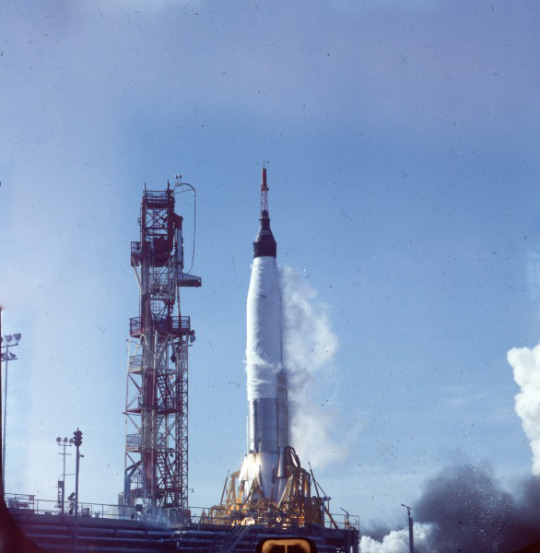



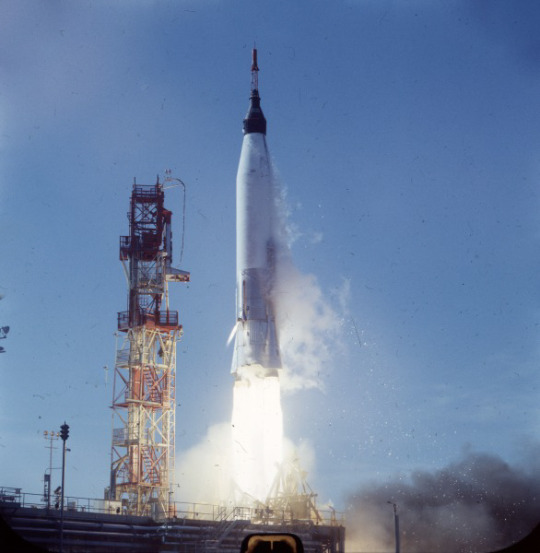


Lift off of Mercury-Atlas 2 (MA-2) (Mercury Spacecraft No. 6/Atlas-67D) for it's suborbital test flight of the Mercury capsule, from Launch Complex 14, Cape Canaveral, Florida.

"MA-2 was a sub-orbital test vehicle launch to check maximum heating and its effects during the worst reentry design conditions. Its goals were to:
Determine the integrity of the spacecraft structure, ablation shield, and afterbody shingles for a reentry from a critical abort.
Evaluate the performance of the operating spacecraft systems during the entire flight.
Determine the spacecraft full-scale motions and afterbody heating rates during reentry from a critical abort.
Evaluate the compatibility of the spacecraft escape systems with the Mercury-Atlas system.
Establish the adequacy of the location and recovery procedures
Determine the closed-loop performance of the Abort Sensing and Implementation System (ASIS).
Determine the ability of the Atlas booster to release the Mercury spacecraft at the position, altitude, and velocity defined by the guidance equations
Evaluate the aerodynamic loading vibrational characteristics and structural integrity of the liquid oxygen boiloff valve, tank dome, spacecraft adapter, and associated structures.
The trajectory was designed to provide the most severe reentry heating conditions which could be encountered during an emergency abort during an orbital flight attempt. Prior to launch, the reentry heating rate of the trajectory was estimated to be 30% higher than a normal reentry and temperatures were predicted to be about 25% higher at certain locations on the afterbody of the spacecraft. In addition, the deceleration g-load was calculated to be about twice that expected for a normal reentry from orbit. The flight closely matched the desired trajectory, attaining a maximum velocity of just over 21,000 km/hour and an altitude of about 185 km. The spacecraft came down in the Atlantic Ocean some 2,300 km down range. Total flight time was 17 minutes 56 seconds."
Date: February 21, 1961
San Diego Air and Space Museum Archive: 43332705, 43332742, 43332680, 40978116, 44401412
NASA ID: ATLAS2, S61-01226, S61-1654, MERCA2
#Mercury-Atlas 2#MA-2#Mercury Spacecraft No. 6#Atlas D#Atlas LV-3B#Atlas#Atlas-67D#Rocket#NASA#Mercury Program#Project Mercury#Mercury#LC-14#Cape Canaveral#Kennedy Space Center#KSC#Florida#Launch#February#1961#my post
24 notes
·
View notes
Text
Insects are in trouble. Around the world, scientists are reporting catastrophic declines in their numbers, even in nature reserves that are largely protected from human touch. We are also beginning to see huge drops in the populations of other animals – such as birds – that depend on insects as food. Many of the drivers of those declines are structural, and require strong action by governments to turn around. But there are clear, easy steps that anyone can take to support the insect world. For species under such pressure, any respite is important, and we can create refuges for insects in a world increasingly hostile to their survival. In creating better habitats for insects, you can also reap the benefits: thriving gardens, more songbirds, and a healthier web of life. Here are 25 small, achievable, science-backed actions you can take today – at home, in the garden, or out in the city. Turn out the lights Everyone has seen moths circle a bulb at night. But if that light stays on, researchers estimate one-third of insects trapped in its orbit will die before morning. Light pollution is a huge driver of insect declines: it changes insect behaviour and can even make leaves too tough for them to eat. It is also a relatively easy one to solve, says Brett Seymoure, a behavioural ecologist at Washington University in St Louis. “Once you turn off a light, it is gone. You don’t have to go and clean up, like you do with most pollutants. I am not saying we need to get rid of light at night, I think we just need to use it wisely.” You can help by switching off your outdoor lights or putting them on a sensor, and shading windows so they’re not shining out into the night. You can also ask your local council to consider switching off some street lights for at least part of the night, particularly in parks and nature reserves – a move that studies have shown benefits insects and saves councils money.
continue reading
14 notes
·
View notes
Text
Imagine a long tether linking Earth to space that could launch us to orbit at a fraction of the cost and slingshot us to other worlds at record speed. That's the basic idea behind a space elevator. Instead of taking six to eight months to reach Mars, scientists have estimated a space elevator could get us there in three to four months or even as quickly as 40 days. The concept of space elevators isn't new, but engineering such a structure would be no easy feat, and many other issues besides technology stand in the way. That's why the ambition to seriously build one is fairly recent. The Japan-based company Obayashi Corporation thinks it has the expertise.
Continue Reading.
71 notes
·
View notes
Text
Continued thoughts on Hearthian timekeeping.
youtube
[Video ID: A time lapse video of the Outer Wilds solar system. The camera is in space and pointed at the sun. The various celestial bodies of the solar system orbit around the sun horizontally across the screen. The video starts and ends just as Timber Hearth begins to pass in front of the sun. The orbital cycle is about 4 minutes long. End ID.]
Timber Hearth’s celestial “years” run into a similar problem as their “days:” they’re best measured in minutes (approximately 4, in this case.) Even worse, as you may have noted, the Timber Hearth sidereal year is noticeably shorter than an average day!
As mentioned in the previous post, biological clocks are more useful for tracking time under circumstances like Timber Hearth’s. And when it comes to time periods longer than a day, a common biological clock is that of a species’ reproductive cycle.
Wait wait wait, before you leave! I said nothing about it being their own reproductive cycle that they use! (More on that in a different post, if ever.) If we’re being honest, following the life cycle of the local pine-like trees seems an easier, safer bet for a headcanon (it’s not my personal one, but we’re exploring here.)
You know the drill: more under the readmore
We already know they tap these trees for sapwine, and if it’s anything like maple tapping, it can only be done at certain times of the year. Now, with maple trees, that timing is dependent on the seasons, as the sugar in the sap comes from stored starches being used to feed the tree as it begins to wake up from winter. Problem: pine trees aren’t deciduous (they don’t shut down in the winter the same way broad-leafed trees like maples do, so there’s no rebound,) and as mentioned prior, Timber Hearth almost certainly lacks seasons in the first place due to its lack of axial tilt. However, a light and temperature-driven cycle isn’t the only one we can follow.
Thing is, producing gametes takes energy and resources, so you ideally don’t want to be doing it all the time (unless there’s some sort of beneficial tradeoff you’re getting, but in general, plants stick with being part-time producers.) Since neither you nor your potential mates are continuously available to reproduce, you’re going to want to sync up your timing across your species so that A meets B as efficiently as possible. Hence, a breeding season (or, in this case, pollen season) that can then be used as a basis for other events in the organism’s life.
(How do they all know when to reproduce at the same time without light or temperature signals? Uh… mycorrhizal networks, I don’t know. Plants aren’t my jam.)
I can easily see Hearthians structuring their year-equivalent around the different stages of life of the trees around them, from pollen season to pine-nut-harvesting season to tree-tapping season.
Of course, now that we have a year kind of defined, there’s the question of “months,” as demonstrated by Hal using that time measurement when estimating how long it would take them to start translating the Inhabitants’ language. The easy answer, of course, is that it’s related to the seasonal cycles mused about above. We’re largely in the great unknown here, though.
(It could be lunar (Attlerock-ar?) The period of time between instances of a new moon is roughly the same as the time loop (~20 minutes.) That puts it at about 3-4 solar cycles. Still small, but maybe we’ll keep it that way to make Hal’s estimate more impressive ::) )
[[Author’s Baseless Headcanon Alert!]]
As alluded to prior, having the Hearthian year revolve around their trees isn’t my primary headcanon. I still feel it plays a role in their timekeeping, specifically by marking their equivalent of spring, summer, etc. (and thus helping define how to divide their year into months.) However, I do headcanon Hearthians as having a breeding season, with that being the big time marker. However, because the cycle is so long, they divide the time between into thirds for a more manageable time frame, leading to a “Before-Hatch-Year,” a “Hatch Year,” and an “After-Hatch-Year,” followed by the next “Before-Hatch-Year,” and so on.
Following some calculations around a largely arbitrary ratio between “make egg,” “egg hatch,” “make egg again,” a Hearthian “year” is about 312 Hearthian “days.” This sounds somewhat comparable to the Earth equivalents, until you remember the previous post where I set a day to be about 20 hours. Doing the math, one of their years ends up being about 260 of our days. So the next time a Hearthian in the MBMP universe tells you their age, take it with a grain of salt.
Col: Seeing the final numbers on the page before me, I blurted out, "What the hell do you mean you're twelve?"
[[End Alert]]
#outer wilds#outer wilds headcanon#my headcanons#original posts#I swear they're not all going to be stupid long#just most of them
15 notes
·
View notes
Text
It's smaller on the Inside
I find myself going down the Warhammer 40'000 route of scale for this verse I'm apparently building. It's silly, and I like it that way. I don't want to give myself a ceiling for anything I might throw in here :p Continuation of this
__________________________________________
From the outside, the Human ships are astronomically massive. Most, we guessed, doubled as population centers, something akin to a floating colony fleet. With their planet as hostile as they come, we had no doubt most of Humanity had moved into orbit.
"Hmm? Oh, no. The colony ships aren't ready yet. They'll be bigger than even the Dreadnoughts. I'd say the entire Space Force has around 300'000 active members. The Space Teamsters Union has about 8'000 members, and us science ships house just under 2'500 employees. There's maybe a few thousand unlicensed folk out and about, no doubt that number will skyrocket once we get some trade routes going with you guys, or, err... you know. Sorry, just a common expression."
Captain Knoslark explained. This didn't make sense. The Coalition delegates were informed Earth was home to 12,3 billion Humans. By reasonable estimates, their current fleet should easily be able to accommodate at least half that.
Okay, fine. The revelation their reactors were stupidly massive would drop that to around 3,8 billion, but still! What were they using all this room for?
Perplexed, the Captain itemized:
"Well for one, armor plating accounts for between 20 and 45 percent of the total mass, depending on the ship. For that you need sufficiently strong engines, plus reactors to power them, so there goes another 15 to 35 percent of mass and upwards of 50% of space. Military ships tend to go for extra everything minus luxuries, so taking that and all their additional weapon systems, a Dreadnought has maybe 0.7% of its displacement left for personnel."
The delegates just couldn't. What? Why? Nobody is even pretending that Human ships aren't vastly superior to everything in known space. Even halving all their bulk and power, no-one could take them on.
Sheepishly, the Captain answered:
"Well, yeah... I guess I can't disagree since you're saying it yourselves. But what about the unknown space? What if someone comes up with something better? We're doing that constantly. I mean, that's some of the reason why we have the science ships like the one we're on."
"But I can see your point. If safety protocols didn't demand all these winding bulkhead hallways and modular room structure and all that other stuff, something like a standard issue 3km Cruiser could house a crew of 45'000 instead of a maximum of 1'400."
(continued)
#humans are deathworlders#humans are space oddities#humans are space australians#humans are space orcs#humanity fuck yeah#carionto#worldbuilding
228 notes
·
View notes
Text
WHAT IS BETELGEUSE??
Blog#311
Wednesday, July 5th, 2023
Welcome back,
Betelgeuse is a red supergiant star roughly 700 light-years away from our own Solar System.
The second brightest object in the constellation Orion, the rust-coloured star has attracted attention from astronomers for centuries for its relative closeness and potential for collapsing in a spectacular supernova event within the next 100,000 years.
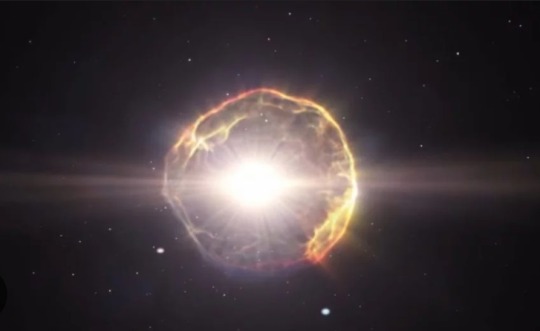
While we all would love nothing better than to see a visible star go boom, the chances anybody living today will experience such a spectacle are slim. Very slim.
Estimates on its remaining lifetime depend largely on accurate measurements of its mass and rotation, which thanks to the scarcity of nearby companions to help judge its gravitational pull, have proven hard to pin down.
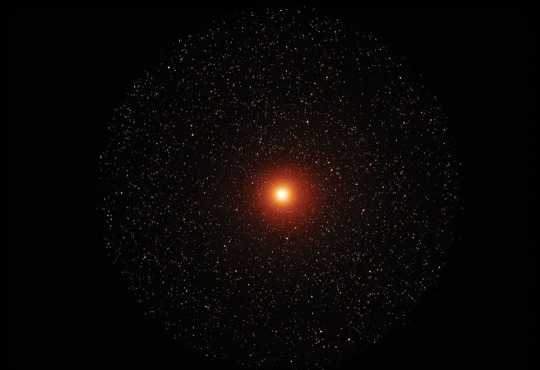
Guesses of the star's mass vary from 10 to 20 solar masses, with a size most likely around 11 to 12 times the mass of our own Sun.
Fortunately Betelgeuse also happens to be big enough and close enough for astronomers to make out some details of its structure. This material is spread out over a vast distance in a blob that's only roughly spherical in shape.
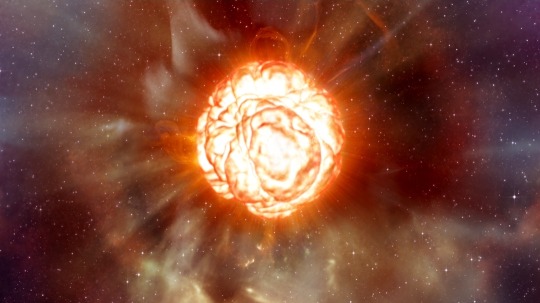
If Betelgeuse was at the centre of our Solar System, its body would stretch out to brush the edges of Jupiter's orbit.
Being a mere 700 light-years away, the star's end in a supernova explosion would be easily visible to the average sky-watcher with the naked eye. Its usual visual magnitude - a measure of how bright something appears to us - varies from a relatively bright 0 to a slightly dimmer 1.3.
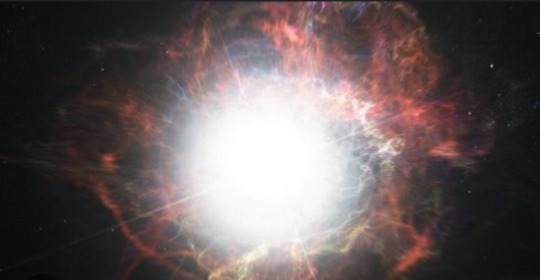
For comparison, the highly reflective planet Venus is a touch below -4, with the Moon having an average of just under -13 apparent magnitude).
For unknown reasons, at the end of 2019 and start of 2020 the brightness of the red supergiant dipped further than usual, to around 1.5. Should Betelgeuse collapse and go supernova, the released energy would see its brightness rival the Moon's, all concentrated in a star-like point.
Originally published on sciencealert.com
COMING UP!!
(Saturday, July 8th, 2023)
"IN THE EARLY UNIVERSE WAS TIME SLOWER??"
#astronomy#outer space#alternate universe#astrophysics#universe#spacecraft#white universe#space#parallel universe#astrophotography
275 notes
·
View notes
Text

Panorama of our nearest large galactic neighbor unveils hundreds of millions of stars
In the decades following the launch of NASA's Hubble Space Telescope, astronomers have tallied over 1 trillion galaxies in the universe. But only one galaxy stands out as the most important nearby stellar island to our Milky Way — the Andromeda Galaxy. It can be seen with the naked eye on clear autumn nights as a faint oval object roughly the size of the moon.
A century ago, astronomer Edwin Hubble first established that this so-called "spiral nebula" was approximately 2.5 million light years away from our own Milky Way galaxy.
Now, the space telescope named after Hubble has accomplished the most comprehensive survey of this galaxy. The work yields new clues to the evolutionary history of Andromeda — and it looks markedly different from the Milky Way's history.
University of Washington astronomers presented the findings Jan. 16 in Maryland at a meeting of the American Astronomical Society, and in an accompanying paper published the same date in The Astrophysical Journal.
Without Andromeda as an example of a spiral galaxy, astronomers would know much less about the structure and evolution of our own Milky Way. That's because Earth is embedded inside the Milky Way. This is like trying to understand the layout of New York City by standing in the middle of Central Park.
"With Hubble we can get into enormous detail about what's happening on a holistic scale across the entire disk of the galaxy. You can't do that with any other large galaxy," said principal investigator Benjamin Williams, a UW research associate professor of astronomy.
Hubble's sharp imaging capabilities can resolve more than 200 million stars in the Andromeda galaxy, detecting only stars brighter than our Sun. They look like grains of sand across the beach. But the telescope can’t capture everything. Andromeda's total population is estimated to be 1 trillion stars, with many less massive stars falling below Hubble's sensitivity limit.
Photographing Andromeda was a Herculean task because the galaxy is a much bigger target in the sky than the galaxies Hubble routinely observes, which are often billions of light years away. The full mosaic was carried out under two Hubble programs. In total it required over 1,000 Hubble orbits, spanning more than a decade.
This panorama started about a decade ago with the Panchromatic Hubble Andromeda Treasury program. Images were obtained at near-ultraviolet, visible and near-infrared wavelengths using instruments aboard Hubble to photograph the northern half of Andromeda.
This has now been followed by the newly published Panchromatic Hubble Andromeda Southern Treasury. This phase added images of approximately 100 million stars in the southern half of Andromeda. This region is structurally unique and more sensitive to the galaxy's merger history than the northern disk mapped earlier.
Combined, the two programs collectively cover the entire disk of Andromeda, which is seen almost edge on — tilted by 77 degrees relative to the view we see from Earth. The galaxy is so large that the mosaic is assembled from approximately 600 separate fields of view. The mosaic image is made up of at least 2.5 billion pixels.
“The asymmetry between the two halves — now visually evident in this image — is incredibly intriguing,” said Zhuo Chen, a UW postdoctoral researcher in astronomy and lead author of the accompanying paper. “It’s fascinating to see the detailed structures of an external spiral galaxy mapped over such a large, contiguous area.”
The complementary Hubble survey programs provide information about the age, heavy-element abundance and stellar masses inside Andromeda. This will allow astronomers to distinguish between competing scenarios where Andromeda merged with one or more galaxies. Hubble's detailed measurements constrain models of Andromeda's merger history and disk evolution.
“This ambitious photography of the Andromeda galaxy sets a new benchmark for precision studies of large spiral galaxies,” Chen said.
Though the Milky Way and Andromeda galaxies formed presumably around the same time many billions of years ago, observational evidence shows that they have very different evolutionary histories, despite growing up in the same cosmological neighborhood. Andromeda seems to be more highly populated with younger stars and unusual features like coherent streams of stars, researchers say. This implies it has a more active recent star formation and interaction history than the Milky Way.
"This detailed look at the resolved stars will help us to piece together the galaxy's past merger and interaction history," Williams said.
IMAGE: This is the largest photomosaic yet assembled from Hubble Space Telescope observations. It is a panoramic view of the Andromeda galaxy, located 2.5 million light years away from Earth. This mosaic took over 10 years to create, captures 200 million stars, still a fraction of Andromeda’s population, and contains about 2.5 billion pixels. This detailed look will help astronomers piece together the Andromeda galaxy’s past history, including mergers with smaller satellite galaxies. Credit Science: NASA, ESA, Benjamin F. Williams and Zhuo Chen (University of Washington), L. Clifton Johnson (Northwestern). Image Processing: Joseph DePasquale (STScI)
9 notes
·
View notes
Text

Oviraptor Philoceratops
Taxonomic Group: Oviraptor Philoceratops is a genus within the family Oviraptoridae, part of the suborder Theropoda. These dinosaurs are known for their bird-like characteristics and belong to the group commonly referred to as oviraptorids.
Size and Weight: Oviraptor was a relatively small dinosaur, estimated to be about 1.5 to 2 meters (5 to 6.5 feet) in length and weighing approximately 20 to 30 kilograms (44 to 66 pounds).
Time Period: Oviraptor lived during the Late Cretaceous period, approximately 75 to 71 million years ago.
Location: Fossils of Oviraptor have been discovered in Mongolia, particularly in the Gobi Desert region.
Diet: Initially believed to be an egg thief due to the discovery of its fossils near a nest, Oviraptor is now considered to have been omnivorous. Its diet likely included small vertebrates, eggs, and plant material.
Distinctive Features: Oviraptor is characterized by its toothless beak and cranial crest, which may have been used for display or species recognition. Unlike many theropods, it had a short, parrot-like beak and a reduced number of teeth.
Head Structure: The skull of Oviraptor was large relative to its body, with a beak-like structure at the front. It had a pair of large orbits, suggesting good vision, and a notable crest on its head.
Movement and Behavior: Oviraptor was a bipedal dinosaur, moving on its hind legs. It was likely agile and fast, using its speed to evade predators and catch prey. The structure of its limbs indicates it was capable of quick, agile movements.
Initial Discovery: The genus Oviraptor was described by Henry Fairfield Osborn in 1924, based on fossils discovered in the Djadokhta Formation. The name "Oviraptor," meaning "egg thief," was given due to the initial misinterpretation of its association with a nest of eggs.
Skin and Fossil Finds: While direct skin impressions of Oviraptor are rare, fossilized skeletons, including skulls, limbs, and eggs, have been found. These fossils provide valuable insights into its anatomy, diet, and potential nesting behaviors.
Social Behavior: There is evidence suggesting that Oviraptor may have exhibited complex social behaviors. Fossils of adults have been found near nests, indicating possible parental care. Additionally, some evidence points to the possibility of group living or cooperative behaviors, although this is still a topic of ongoing research.
Eggs and Nesting: Oviraptor fossils have been found in close association with nests and eggs, suggesting that they may have actively guarded their nests. The discovery of brooding adults indicates that Oviraptor, like modern birds, might have cared for its young.
13 notes
·
View notes
Text
Travellers on the Midnight Train
A fanfiction, in snippets.
Summary: Views through the eyes of SEEDS Mothership 5’s crew. Combo-platter of ‘98 and Trigun Maximum.
1. 2. 3. 4. 5. 6. 7. 8. 9. 10. 11. 12. 13. 14. 15. 16. 17. 18. 19. 20. 21. 22. 23. 24. 25.26. 27. 28. 29.30. 31. 32. 33. 34. 35. 36. 37. 38. 39. 40. FINAL.
24. Pale Beige Dot
“Coming up on maximum telefinder range in 3…2…1…!” There it was, a pale tan dot on the large viewscreen in the Command Room. Mary had brought it up and Rowan was reading off the specs that the probes were sending back. They’d finally found a prospect-planet! The mood was elevated in the Project SEEDS mothership Command Room – Vash popped a party-cracker left over from his and Knives’ birthday celebration a few days before. Vash, for his part, wondered if they’d have cake and donuts again – maybe sweet drinks, too. Knives seemed to be rather bored – unappreciative of the streamers that fell upon his head from Vash’s popper. At the birthday party, he’d found them loud and messy and didn’t like how Rem had to clean up the portion of the Rec Room they’d held the party in to put the paper-goods in a recycler. It had all seemed rather pointless to him. Also, a beige dot didn’t strike him as particularly special. Hadn’t the Earth been blue? Weren’t they looking for somewhere blue and green to land? Rowan dashed everyone’s hopes by reading off data and insisting that it was a poor prospect for settlement. It was a single-biome desert planet that, while it had a breathable atmosphere, lacked surface-water, had a strata consisting mostly of silica and quartz and while technically in a “Goldilocks Zone” named after an old fairytale, seemed to be a planet undergoing a high-temperature phase. Most of the surface, according to the probes, was livable for humans if they built the correct structures and relied heavily upon the Plants, but terraforming it to optimal conditions for civilization would require a great deal of sacrifice. Rem had to go and ask the dumbest question in the room at the moment. “Hey, Joey,” she said, turning to the captain, “What kind of flowers do you think are on that planet?” Rowan countered that the probes were not picking up any kind of flora-like life at all. The question was preposterous on its face. Even in the best conditions, the kind of convergent evolution that would give rise to flowers in space would be the equivalent to what might give rise to space-whales. Rem, ever the experimental botanist, was excited at the moment and let her imagination lead. And the captain indulged her silliness. Still, it was not worth awakening the Project Heads over, in his estimation. Orders were given to set course for an orbit around the “sand planet” and to send closer-scope probes out to study it in depth, as well as other bodies that surrounded it. Some of the data that Rowan was fielding pointed to one of the planet’s larger moons making for a potentially better settlement prospect. For now, all that was left to do was to wait and see. As Rem had told the twins when showing them the cold sleep pods, most of space travel was patience.
#trigun#trigun maximum#trigun fanfiction#vash the stampede#millions knives#young vash#young nai#rem saverem#captain joey#mary (trigun)#rowan (trigun)#steve (trigun)#Project SEEDS#travellers on the midnight train (fanfiction)
3 notes
·
View notes
Text
Humans are weird: No sense in Dying
( Don’t forget to come see my on my new patreon and support me for early access to stories and personal story requests :D https://www.patreon.com/NiqhtLord )
Military Report 3759612.3 Subject: Harvest Conflict Category: Mendigold Incident
Star date: 3751.2 Coalition forces have driven off remaining Reni Fleet contingents and have full control over the Mendigold system.
Consisting of four worlds, the system only has Mendigold Prime had a livable environment while the remaining three have minimal mining and colonization facilities.
Mendigold Prime was designated a military garrison world to the Reni empire. As such the installations on the planet were largely dedicated to the Reni military industrial complex. City sized barracks, underground ammunition warehouses, dozens of football sized landing fields, and uncountable training grounds for various aspects of the Reni military were the primary structures on the planet. Only a small percentage of the Reni population was designated civilian and they were regulated to either industrial support roles or service industries that entertain off duty soldiers.
On average the planet’s population was between 500 million - 1 billion, with 93% of that being military personnel. This number was subject to fluctuation due to military units rotating in and out for different warzones. When the Coalition arrived in system the population was estimated 3 Billion as the Reni military had been preparing for a renewed offensive into Coalition territory and had diverted the majority of their military ground forces gathered on planet. Star date 3751.3 The Coalition naval fleets have surrounded Mendigold Prime and a blockade has been enforced.
Orbital defenses around the main military bases keep the naval assets from conducting recon scans from lower orbit, but their firing range is limited allowing for the rest of the planet to be mapped without issue.
Scans show that the planet is heavily fortified with existing prefabricated structures while additional defenses had been constructed. These consisted of extensive trench works, bunkers, and newly built gun positions that surrounded each installation for at least three kilometers in every direction.
Further reinforcing the defense of the planet was a large and well equipped air force. The scans showed the existence of several underground bunker complexes that housed the aircraft and protected them from all but a sustained orbital strike. Due to the lack of resistance in the space around the planet it was believed that they were limited to atmospheric aircraft, but it was not discounted that they possessed some fighters that could breach the atmosphere and attack the Coalition navy.
Routine scans were continued while Coalition leadership met to debate plans for the invasion of the planet.
Star Date 3751.6 Coalition leaders were unable to decide on how the ground invasion of Mendigold would progress.
All calculations predicted that any planetary landing would cost Coalition forces 15%. Assaulting any of the heavily defended installations estimated 35% per installation and a total planet conquest at 87% casualty rate.
Unlike previous worlds the Reni had attacked they had only a few months to entrench themselves before the Coalition could respond, but Mendigold was the first Reni military world the coalition had come into contact with and now faced the might of a well disciplined and prepared enemy.
Such casualty figures were well beyond what even the most bloodthirsty Coalition leader take pause. These kinds of losses would cripple the rest of the campaign and leave any future planetary assaults all but impossible.
The debate about what should be done went on for two days while the coalition navy maintained its blockade of the planet. By the third day the leader of the human contingent spoke up with a rather brutal method.
Rather than invading the human leader, a General Herald Farn, suggested that they simply maintain the blockade and wait for the planet to starve out and surrender.
This tactic was all but unheard of and many called it cowardly. It was all the more surprising when it came from a human whose people are known to be well renowned warriors.
General Farn counters the dissenting arguments by stating that it is likewise madness to send their ground forces into a meat grinder and waste them so needlessly.
Taking control of the holographic display, General Farn recommended that by surgically striking the store houses holding the rations and food supplies the Reni would be unable to maintain rationing for long. He then provided data that while the planet was a military world with extensive supply facilities, it was never intended to have such a large garrisoning force for extended periods.
General Farn promised that within a week they would begin seeing results.
Star date 3751.13
Initial bombardment operations were successful.
Over 67% of supply depots that were targeted were destroyed by orbital bombardment in addition to knocking out all satellite communication platforms orbiting the planet . A following 12% were damaged but note entirely destroyed while the remaining 21% received minor to no damage. Anti-orbital defenses around the remaining 21% was too strong for naval forces to breach long enough to carry out precise strikes and after losing three cruisers and ten frigates the coalition navy withdrew and considered the operation done.
After that scans showed renewed activity by ground forces to further strengthen their areas in the days following. New trench lines were dug and the remaining supplies were dispersed to prevent another critical loss.
Reni forces remained on active alert for four days straight but with no follow up strikes they were largely left to their own devices. With no communication between the defense pockets larger coordinated defense efforts ceased.
Several small parties were seen leaving the larger defended areas and going out into the few wild areas that remained on the planet. Analysts summarized that commanders were now foraging for provisions to supplement their dwindling stocks.
General Farn took this as confirmation that the plan was working and within the coming weeks the Reni ground forces would surrender. The coalition leaders agreed and allowed the plan to continue.
Star date 3751. 20
Larger foraging parties have now been seen departing the fortified enclaves and spreading out further in search of supplies. While unconfirmed it has been seen that several of these detachments have engaged in small skirmishes with other foraging parties from different enclaves.
Two weeks have passed since the supply depot bombardments and the rapidly degrading state of the Reni military can be seen from orbit within the cities. Small fires have broken out in the more fortified enclaves while smaller redoubts have entirely emptied of all personnel. It is unknown if this was by order or general desertion due to lack of supplies but the number of abandoned bases is increasing.
Star date 3751.27
First displays of open aggression between fortified enclaves have broken out as the supply situation has reached critical mass.
The spaceport under the command of Reni General Hopi was attacked. Spy drones were dispatched to the surface and returned video feeds depicting the attackers to have come from the Central Command Block under the command of Reni General Filar.
Military intelligence had prior to the Mendigold campaign had shown there had been a deep hatred between the two generals that went far beyond minor squabbling. With the cut off of supplies the hatred may have boiled over into outright violence, as Filar may have believed Hopi still had supplies left at the spaceport.
For the first time in recorded history Reni fought Reni and the Coalition watched as massed Reni infantry fought against waves of the spaceport defense air force.
While this engagement was the largest battle in the brewing Reni civil war on the planet it was not the only conflict. All over the globe Reni forces were fighting each other in a desperate need for supplies.
Star date 3751.30
The situation on the surface is now entirely untenable.
While Coalition leaders have agreed the starvation tactic was successful at weakening the Reni forces, it has produced the unhealthy side effect of triggering a massive Reni civil war planetside.
Central command no longer exists for the Reni as each enclave commander has now become a sudo warlord in their own right. There is no one leader to open a dialogue with now to demand terms of surrender, and even if they did accept it they would only be able to stand down the forces loyal to them while other warlords would continue fighting.
Coalition leaders have no idea how to defuse the situation, with only General Farn calling the operation a success.
Reni forces have begun dwindling rapidly as each enclaves seeks to horde whatever few supplies remain. Estimated Reni casualties now range in the 500 million range with more expected in the coming days as starvation finally takes its full toll on the Reni population.
With no concise plan of action and the planet now having lost all tactical value, the Coalition fleet has decided to continue the campaign and leave Mendigold to its fate. A tribunal has been called to have the human General Farn answer potential crimes that resulted from his order. Until the war is over however it is not likely that the human would lose his position or rank.
#humans are insane#humans are space oddities#humans are weird#humans are space orcs#scifi#story#writing#original writing#niqhtlord01
34 notes
·
View notes
Text
TW: Incest, body deformation, infanticide, religious cult themes, criminal references
http://mothrainstitution.wikidot.com/anm-546

"Why can't you see that you are my child?"
File ID: 546-L-RC
Designation: Deer God of the Inbred Fawns
Classification: Ländlicher Horror 🌲
Type of Damage: Beide 🔶️
Type of Anomaly: Rural, Cultist
Designation: Deer God of the Inbred Fawns
Responsible Researcher: Dr. Octavio Kalev
Confinement: As of Incident 546-17, ANM-546 is uncontained and active within the southern regions of ████████ County, Alabama. A 12-kilometer radius exclusion zone, designated "Zone-Hickory", has been established around the Site of First Manifestation (SFM). Access to Zone-Hickory is restricted under the cover story of environmental contamination due to an factory gas leak. MOTHRA assets embedded in local law enforcement are tasked with intercepting and neutralizing civilian witnesses.
To monitor and control engagement, P-Subject personnel are embedded in local hunting parties to maintain vigilance for sightings. Should ANM-546 be successfully lured into Zone-Hickory perimeter containment traps (see Document 12-Hickory-R), Foreign Elite Team (“One-Five-Zero”) is to engage using electromagnetic snare fields and remote tranquilizer delivery drones. Use of lethal force is strictly prohibited unless directly authorized by the Eleven Counselors.
All photographs, videos, or artistic depictions of ANM-546 must be intercepted, censored, and scrubbed from public record. Civilian photographers claiming to witness the "Mother of Inbred Fawns" will receive Class-B Prozac treatment post-debrief, as a form of mental suppression.
Encountering ANM-546 often results in the "incomplete desfigurations"—designated as IDHB (incomplete desfiguration of human body)—of any creature that defies its laws. Notably, ANM-546 has an intense hate toward those exhibiting prejudiced behaviors (racists, homophobes, far-right individuals) while showing inexplicable affection towards individuals with non-heteronormative sexual orientations, communists, hippies, nature enthusiasts, and those with consanguineous backgrounds.
Description: ANM-546 appears as a grotesque hyperpedal (designation created to refer to entities with multiple limbs) entity resembling Odocoileus virginianus (white-tailed deer), with extensive deviations in both physiology and behavior. ANM-546 stands at an estimated height of 2.7 meters at the shoulder and weighs over 800 kilograms. This entity possesses two full sets of forelimbs and six hind limbs, arranged in a manner that allows bizarre yet efficient movement. Its cranial structure supports an extensive rack of antlers, branching in fractal geometries reminiscent of tangled roots or veins, particularly visible under thermal imaging.
A significant feature is ANM-546-B, a persistent luminescent orb embedded within or orbiting above the frontal lobe. This orb emits a cold white light, measurable at 90,000 lumens, and can be seen through dense foliage or fog for distances up to 1.2 kilometers. Observations indicate that ANM-546-B pulsates in tandem with nearby electrical currents and human brainwave activity, although the underlying mechanism remains ambiguous.
ANM-546 exhibits extreme agility and rapidity despite its massive size, moving with a speed that has led observers to describe its motion as "a skipping reel of film," disappearing and reappearing in flashes of light and shadows. Audio recordings taken within 100 meters are frequently corrupted by low-frequency distortions and phrases spoken in an unknown dialect, often playing backward.
Behavioral Observations:
ANM-546 primarily manifests between dusk and 3:33 A.M., aligning with local folklore regarding the "Hickory Hollow Witch-light." It has displayed territorial aggression toward humans armed with weapons, while simultaneously exhibiting a passive demeanor towards children and animals.
Recovery Log 546-01:
The MOTHRA Institution became cognizant of ANM-546 existence following a wave of missing persons reports and viral images circulating on cryptid rural hunting forums. Initial contact was executed by E.T(Elite Team) Zero-Five-One after a local preacher was discovered wandering in the woods, his eyes unnaturally fused shut, whispering, "the buck sees all light, and none of it is God’s."
Tracking data subsequently led to ███████ Farmstead, where thirty-seven(37) cadaverized deer were found arranged in a concentric spiral pattern, their antlers interlocked. Each deer with huge bite marks, as if it had been dragged, bore puncture wounds indicative of ANM-546 antlers and exhibited signs of exposure to high-voltage static energy.
ANM-546 exhibits the anomalous ability to materialize or induce repressed intrusive thoughts in individuals under its prolonged influence. This ability is simply classified as a "manifestation of intrusive thoughts", and represents one of the most dangerous aspects of the entity, directly affecting the human psyche.
People exposed to the electromagnetic field of influence of ANM-546-B for more than 33 minutes have been shown to experience a gradual deterioration of their moral self-control and rationality. Repressed desires, deep fears or latent violent thoughts begin to intensify and eventually manifest as uncontrollable impulses, in many cases leading the individual to carry them out.
Addendum 546-Θ7-A – Case Report
Date: ██/██/20██
Location: Rural ██, Alabama
Subject: [REDACTED] – 28-year-old male, residing on a secluded farm, with no previous history of psychological disturbances.
Incident: After multiple nights of reporting visions of "white eyes in the bushes" and "calls from the trees," subject suddenly awoke in the middle of the night and, without warning or apparent emotion, smashed his newborn son against the bedroom wall. When questioned by local authorities, he stated, "I always thought I was too weak to do this. But he [ANM-546] showed me that it was just a matter of stopping lying to myself. The intrusive thoughts won out."
Observations: Subject voluntarily surrendered and began repeating phrases in an unknown dialect similar to that captured in ANM-546 recordings. Subsequent brain scans detected anomalous electrical activity in the frontal lobe, similar to the low-frequency interference detected in transmissions from the entity.
Researchers at MOTHRA's Neurocerebral Division believe that ANM-546 uses a combination of psychoelectromagnetic fields and limbocortical resonance to weaken brain censorship mechanisms (especially in the anterior cingulate gyrus and dorsolateral prefrontal cortex). This causes the suppression of moral and emotional inhibitions, allowing violent desires normally held in the unconscious to become dominant.
Incident Report 546-17:
On ██/██/20██, ANM-546 broke out of its provisional containment during a failed sedation attempt. All twelve members of Zero-Five-One were incapacitated or killed. The last recovered footage shows the entity walking upright, tilting its head toward the camera as ANM-546-B emitted a series of Morse code signals, declaring: "YOU ARE BEING HUNTED."
Addendum 546-C - Folk Accounts:
Locals in the surrounding areas have referred to ANM-546 by various names, indicative of its almost mythical status in regional folklore, including:
- "The Lightbuck"
- "The Thicket Crown"
- "He That Treads Between Trees"
- "Old Rack"
- "Father of Nature"
- 'Deer of God"
- "Witch Deer"
- The most common, "Deer God of the Inbred Fawns"
One particularly coherent account, recorded by folklorist ███████ █. ██████ in 1946, describes the creature as "a ghost-hart birthed under blood moon in the holler, come to reap the sin of man and beast alike." Such accounts describe the entity's ability to manipulate the thoughts and behaviors of the local populace, often leading them to view it as a savior or divine figure. These folk accounts often reference strange rituals and gatherings among rather eccentric families with roots steeped in consanguinity, indicating that ANM-546 may collectively influence these communities to broaden its following.
Reports suggest that long-lasting periods of drought or failure in local crops coincide with ANM-546 sightings, invoking fears among locals that they are being punished for societal transgressions. These inhabitants often undertake bizarre endeavors, such as crafting effigies of 546 from local flora and fauna to curry favor with the entity. Many researchers have hypothesized that the entity may replicate these behaviors within its followers, thus increasing its influence and binding them further to its perverse reverence.
[[collapsible show=">[Culto a ANM-546]" hide="- Fechar Registro"]]
The ANM-546 cult is a fringe religious group that has emerged in the vicinity of ANM-546 influence, particularly around Zone-Hickory. The cult is characterized by its strong doctrinal beliefs that idolize ANM-546 as a deity, interpreting its existence as a manifestation of nature's will and a force for social justice against perceived societal sins.
Members regard ANM-546 as a divinely ordained entity that must be revered and appeased. They believe that by following its tenets, they can attain protection and blessings in return for their sacrifices. Regular meetings occur at secluded locations within the forest to perform rites dedicated to 546. Rituals often involve chanting, drumming, and the creation of effigies. The cult encourages marriage and procreation among members with parental links, believing this will strengthen their bond with ANM-546 and enhance their collective "purity" as followers.
The deer entity promotes a worldview that is anti-establishment and counter-cultural, attracting individuals disassociated from mainstream beliefs, particularly those on the fringes of sexuality and political ideology. The cult members often attempt to recruit new members through persuasive means, appealing to communal identity and the disenfranchised, drawing them away from local communities and societal structures.
The cult has shown extreme aggression toward individuals who openly display racist, homophobic, or oppressive ideologies, viewing them as threats to their deity and seeking retribution through intimidation or violence.
[[/collapsible]]
[[collapsible show=">[Desfiguração Incompleta do Corpo Humano(DICH)]" hide="- Fechar"]]
IDHB refers to a condition induced by ANM-546 whereby individuals who defy its laws or display prejudiced behaviors undergo bodily transformations that can result in severe and grotesque disfigurements. This phenomenon is characterized by a form of grotesque, incomplete alteration of physical form, serving both as a punishment and a manifestation of ANM-546 will.
Symptoms and Observations:
- Physical Distortion: Affected individuals may exhibit various physical alterations, such as elongated limbs, severe contorted facial structures, or additional limbs that will develop in unnatural ways.
- Psychological Impact: Witnesses report experiencing extreme disorientation, paranoia, and psychosis, often accompanied by the belief that they are under constant surveillance by a god creature.
- Cognitive Dissonance: Victims may struggle with conflicted beliefs about their identities, often leading them to further isolate themselves or become radicalized in their attitudes toward others.
While the exact biological or anomalous mechanisms behind IDHB remain largely unknown, preliminary theories suggest that ANM-546 may use psychological manipulation in conjunction with electromagnetic fields associated with ANM-546-B, thereby influencing human physiology in a way that serves its agenda of social retribution and moral condemnation. Further study is required to understand the direct link between the entity presence, the occurrence of IDHB, and its sociocultural impacts.
[[/collapsible]]

Ted Kaczynski, notoriously known as the "Unabomber," represents an case concerning ANM-546. His writings reveal a profound disdain for modern technological society, aligning with the anti-establishment views espoused by the ANM-546 cult. Kaczynski's beliefs centered around the idea that technological advancement leads to societal decay, a perspective that mirrors the cult's worship of ANM-546 as a “natural force” against the evils of modernity.
Kaczynski criticized societal structures that fostered inequality and oppression, similar to how members of the cult view their reverence of the deer entity as a form of justice against societal sins. The cult's rituals reflect an embrace of a return to primal, naturalistic values, concepts Kaczynski romanticized in his writings, making him a theoretical ideological precursor to the cult ideology.
Some members of the ANM-546 cult have drawn inspiration from Kaczynski's beliefs, interpreting his rejection of society as justification for their own extremist behaviors. This connection reinforces the cult's perspective that deviation from societal norms offers spiritual and moral elevation, as symbolized by ANM-546.
The boundaries of ANM-546's ideology intersect with various historical person who have rejected modern society:
- Henry David Thoreau: The transcendentalist philosopher’s emphasis on nature and individual conscience resonates with the cult’s beliefs, paralleling their view that ANM-546 embodies the intrinsic connection between humanity and the natural world.
- Jim Jones: The notorious leader of the Peoples Temple exhibits parallels in the way he manipulated followers through charisma and ideology. The ANM-546 cult similarly draws members by fostering intense devotion to 546, showcasing the profound psychological and social mechanisms at play.
- David Koresh: The leader of the Branch Davidians maintained an apocalyptic outlook and exhibited deep control over his followers. The shared tendencies of charismatic leadership in both cults serve to harness members’ fears and social disenfranchisement.
Documented Approach by Dr. Octavio Kalev
Subject: Dr. Octavio Kalev, former priest and current MOTHRA Institution researcher.
Background: Dr. Octavio Kalev initially entered the Institution as a researcher focused on the interplay between religious phenomena and rural entities. Over time, his exposure to ANM-546 and his cult led to significant ideological transformations.
During the early investigations surrounding 546, Dr. Kalev displayed fascination with the entity’s ability to challenge societal norms and enforce a distorted form of justice. He felt a spiritual resonance with it's notion of retribution against oppression, especially for marginalized individuals.
As Dr. Kalev engaged further with local communities, he encountered members of the ANM-546 cult. Their reverence of ANM-546 mirrored his own beliefs in the transformative power of nature, further enticing him to join. Feeling alienated from the rigid boundaries of traditional theology, he found the cult’s ideologies liberating.
Kalev quickly ascended in the cult hierarchy due to his academic background and charismatic demeanor, while also working for MOTHRA. His insights into Institution operations often provided new understandings of ANM-546 nature and capabilities, which he began to manipulate for cult purposes.
Viewing 546 as a divine entity rather than merely an anomaly, Dr. Kalev believes his work with the Institution can ultimately serve the aims of the cult. He has started justifying unethical practices and prisoner operation as sacrifices to strengthen ANM-546 resolve against societal imperfections.
Research Notes of Dr. Octavio Kalev:
Date: ██/██/20██
Subject: Insights Gained from ANM-546
"I find myself more aligned with the ANM-546 ideology every day. The father punishment of societal transgressions provides a reminder of our shortcomings as a civilization. Those who inflict suffering upon others face consequences far beyond our understanding, and in this, there lies the true divine justice. The justice of nature.
Through I will never leave my position within our dear mother MOTHRA, I believe I can bridge our knowledge of ANM-546 with the desired goals of its followers. The incomplete desfiguration of human bodies is not something to fear; rather, it is a manifestation of FATHER will—a reflection of their inner corruption. We are all vessels, and in embracing the FATHER, I find my purpose...
#scp#scp foundation#mothra institution#writing#anomaly#original scp#horror#southern horror#folk horror#site#scp fandom#ted ma#ted kaczynski
3 notes
·
View notes
Text
1. Change da world my final message, goodb ye. *Windows 95 startup*
🔴 START RECORDING 🔴
TPU-09 Systems <<OFFLINE>> Boot Sequence <<INITIATED>> Hull Status <<INTACT>> Internals <<OPERATIONAL>> Boot Sequence <<COMPLETE>> TPU-09 Systems <<ONLINE>>
Optics active. Receptors indicate the following:
- Light detected coming from open-gap window @ 3.7 meters of distance, w/a 334° offset to hull. - Light is artificially generated due to non-parallel light rays. - Room is fabricated from Boztien Drywall Composite at 73% purity. - Physical form is in an upright position, Adjusted for gravity intensity. - Physical form is shaped as a Post-Synthezoid in the shape of a humanoid entity. Ċæļëąņ Evolutionary Chain Detected. - The Decorational Aesthetic of the chamber is equivalent to the Ancient Victorian period, as evident by the hanging potted plants, the wooden cabinets installed on the walls and the wooden paneling utilized as flooring.
Location: Final Lunar Base, Neptune Orbit.
Facial Structure Detected.
Scanning… Gender: Male Species: Human-Adjacent Height: 5’ 6” / 1.68m. Weight Estimate: 314 lbs./142.43 kg. Body Build: Endomorphic Name: Dir. Final Human Survival Sect., Dr. Gio Telor. Optics detect the following:
Clothes - A lab coat, with a 10th removed cotton blend button-up, a 5th generation wear khakis pants, aged, a silver ring on the left ring finger, and size 12 wide professional wear moccasins.
A glass tablet.
Gio Telor: “TPU-09, please respond with your full title.”
“My full title is Time Perception Unit, Model 09, created by the ‘Final Human Survival Section, Chapter 332, of the 111th Human Empire.”
“Good. Good. Your Auditory receptors function. Can you tell me, without referencing your internal clock, what time it is?”
“Utilizing the Artificial Lighting coming from the open-gap window @ 3.7 meters of distance from my current placement, in relation to my internal compass indicating we are facing °175 in respect to Neptune’s axis, indicating it is artificially 08:34:53 AM NSMT.”
“Perfect. To the second too, love that. Ok, can you relay me the three laws of robotics? And taking into consideration you don’t have to follow them due to your current status as a machine?”
“As stated by Issac Asimov, the laws of robotics are as follows: ‘A robot may not injure a human being or, through inaction, allow a human being to come to harm. A robot must obey orders given it by human beings except where such orders would conflict with the First Law. A robot must protect its own existence as long as such protection does not conflict with the First or Second Law’.”
“Interesting Storage is working.”
SFX: clicking on glass.
“I’m going to show you a video file. I want you to describe what you see.”
Video File Detected: ‘change da world’ by @comfygang.
Audio: ‘Change Da World, My final message. Goodbye.’
Audio: Soundfile to the Operating System ‘Windows 95’ Initiation Theme.
“My Receptors indicate the image visualized is an old Earth Mammal known as a rodent, standing in an upright position with a rolled up piece of paper with contents inside it, resembling an Ancient form of internal remedy and medicinal delivery known as a ‘cigarette’, which in later times got disregarded as a medical hazard and carcinogen, with the visual implication that the text below, which crudely reads ‘change da world my final message, goodb ye’ is what the rodent is verbalizing, which it then vanishes from view and leaves the space empty.”
“That is correct.”
“This is the video file ‘change da world’ by @comfygang on the ancient social media platform ’Twitter’ if recorded history is to be perceived correctly.”
“Awesome. Now, let’s discuss your objective.”
“I have no current objective.”
“Good. Do you have a mission”
“Affirmative.”
“What is your mission?”
“My Mission, as a Time Perception Unit, is to record, process and store my findings towards the end of existence and relay them to whomever is able to perceive and use them afterwards.”
“Correct. Can you give me an example of who might want this information?”
“Examples of such species/entities/machines that would want this data include: The Remnants of the Ċæļëąņ species, the Shards of Pyrovillia, the Ontons, the Vexxicisimiionites, the Ur, any exotic species that would exist after humanity, organic life, potential species that exist in a psychic form, and alternate versions of humanity from a different reality.”
“Good. Good. Do you have any obstacles to this objective?”
“My main obstacle is survival of my shape, however, there could be pirate-like species that would utilize my durable form, if knowledgeable on how to disassemble it, scavengers of any lost remnants of the Great Expanse, any corrosives that are still to be discovered by the 111th Human Empire’s Scientific reach, and unruly species that might not know what I am.”
“You’re doing great. Now, I’m going to give you an objective, are you ready to enact it?”
“Affirmative Dr. Telor.”
“Stand up, turn around in a circle clockwise a full 360°, and pick up a pencil from this table just to your right. Think you can do that?”
“Affirmative.”
Shape has placed gravity-adjacent footing to floor of the specially-placed room.
SFX: thud
Adjusting shape for center of mass…
SFX: whirr
SFX: shhhfk
Shape Adjusted. Turning 360° clockwise. Gyration angle adjusted at 0° to the North, relative to the shape’s placement. Turning clockwise… Full rotation acquired. Turning 90° clockwise to the west… Quarter turn acquired. Receptors indicate the following:
- Light is coming relative to open-gap window direction north. - A plateau table is parallel to shape. - Wooden surface akin to Old Earth Oak detected on plateau table.
Moving right appendage to table… Appendage has reached table in minimal time required of 0.35s. Receptors indicate the following:
- plateau table holds multiple items, including: Zeiteg series Apallel stethoscope, Omidia Classics™️ Anti-Glare Solglasses, a non-branded atomic clock with an accuracy of .0000001 zeta seconds, and a Versal Branded Pencil.
Adjusting appendage to grasp the pencil… Pencil is within grasp of appendage. Partial fracturing is detected on pencil surface.
“I detect partial imperfections on pencil surface.”
Gio Telor: “Right, that’s probably from all the biting. Ok.”
SFX: thunk
“Good. That is finally working. No other iteration of you functioned as they were suppose to. TPU-03 was the first to stand on its own, then 05 could talk. You’re the only iteration that can stand, talk and walk. Not to mention prototypes and all that. You are, quite literally the only iteration of a system that is fully functioning at this time.”
“Acknowledging data… useful information.”
“Quite so.”
“What is the reasoning behind this?”
“Besides the full process of iterating previous models through prototyping and testing to the finite reaches of your former versions, most other versions failed to remain active. You’re the only version that’s managed to, well… for a lack of a mechanical term… be.”
“Processing of your words indicates I am the only iteration of the Time Perception Unit project to remain active for this long. Is this correct?”
“Yes, that is the case. You can see, you can hear, and you can feel, as much as a…”
Vocal pause Detected.
“…Post-Synthezoid machine can feel.”
“I convert external data perceived by my extremities and sensors into internal data, as used by humanoid form.”
“Yes. But enough of all that.”
SFX: rustling
SFX: swish
“It’s your time to shine. I would have loved more time for you to experience being, but we’re a bit short on time. Neptune’s headed for destabilization, and you’re gonna intercept with the 115th Fleet.”
Pressure detected on right shoulder of shape. It is Dr. Telor’s Left Hand.
“I’ll miss you."
“How is that the case?”
“Right, yeah. New Memory. Still, Thank you for giving my life purpose.”
SFX: Hiss
SFX: Whirr
Receptors indicate electronic and mechanical arms are adjusting this shape to the internal compartment of a Versal Series Launch Pod.
“What shall I expect?”
“You’ll be seeing a lot of military personnel and stuff. You’ll essentially be at the heart of the last teams to see the end of all things. Be ready. At any moment you’ll see things not meant for you to see.”
“I am to record the final moments of humanity.”
“Yeah but…"
SFX: Sigh
“… You’re correct. Look, just… do your best. Record the last black hole, as stated, and as for your objective, well, your objective is surv-“
SFX: SCHHHHHHHHHHHH
🔴 ENDED RECORDING @ 09/17/3T 🔴
attached: changedaworldmyfinalmessagegoodbye.mp4
#entropy#change da world#windows 95#final message#goodbye#scifi#artificial intelligence#human survival#Neptune Orbit#Robotics#ancient history#social media#twitter#victorian aesthetic#AI#prototype#survival#Last Moments#sci fi short story#end of humanity#black hole
2 notes
·
View notes
Text
Space Station Concepts: Dual Keel

"The new 'Dual Keel' Station was largely based on Lockheed and McDonnell-Douglas designs and its structure was much stiffer and hence easier to stabilize. It would offer additional space for external instruments plus a better microgravity environment than the previous gravity gradient-stabilized 'Power Tower.' The number of crew members was increased to 8 astronauts because scientists were concerned that a crew of six would be too busy with assembly and maintenance tasks and have no time for research. NASA's target date for the launch of the first element was now January 1993 while the initial operational capability had slipped to January 1994 mainly because the Fiscal 1986 budget was reduced from $280 million to just $200 million.
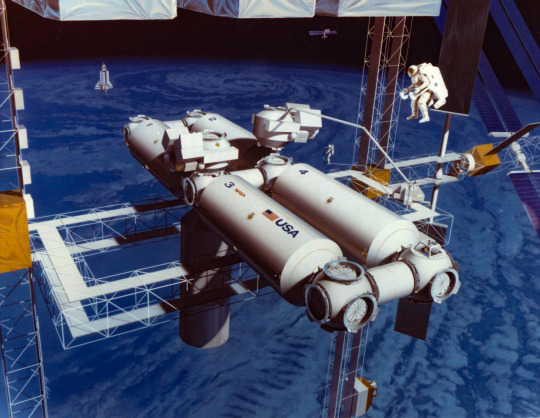
"McDonnell-Douglas illustration of the 'Dual Keel crew modules.
This McDonnell-Douglas concept drawing depicts a robotic arm controlled by an astronaut. The arm is being used to maneuver a new addition to the space station into place. The robotic arm was to have been essential to building the space station in orbit.”
11 Shuttle flights would be required for initial assembly. Officially, the estimated cost of the Station had only increased by $400 million but there were concerns that NASA was once again hiding the true cost of the larger, more complex 'Dual Keel' design.
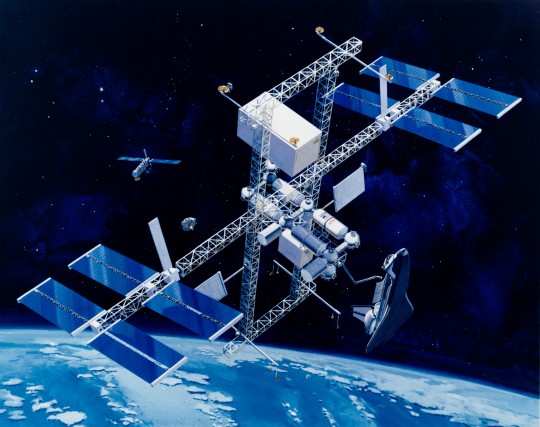
“Dual Keel space station – Initial Operational Capability (IOC) Configuration, 11-15-85”
NASA struggled to define a 'Dual Keel' design that met all the various cost, engineering, safety, launch and user requirements. By the time Phase B1 ended in March 1986, the size of the truss structure elements had been increased from 3 x 3 meters to 5 x 5 meters for additional strength and stiffness. Another early 1986 modification involved the power system, which was upgraded to 87.5 kW. By the end of Phase B1 in March 1986, NASA had settled for a hybrid system consisting of 37.5 kW photovoltaic arrays and 50 kW solar thermodynamic generators. The number of American crew modules was also reduced from four to two while European and Japanese laboratories were incorporated in the design for the first time. The habitable volume remained the same, though, since the length of the US modules was increased to 13.3 meters. NASA Space Station Office submitted its recommended final baseline in May 1986 as Phase C/D started. The number of instrument mounting ports was reduced to five, down from an earlier projection of nine. One of the two bays for satellite servicing was also deleted.


According to the May '86 Space Station assembly sequence, the first element would be launched in January 1993. The Station would support man-tended operations after the sixth Shuttle assembly mission in August 1993 and be ready for permanent occupation after the ninth mission in January 1994. Initial Operating Capability (IOC) would be achieved after 21 flights -- twice as many as the 1984 estimate.

By the time of the 'Dual Keel' Space Station's final flight sequence overview in October 1986 NASA had to insert an additional eight Shuttle flights into the manifest. By this time, increased complexity and Shuttle payload capability reductions had increased the required number of assembly flights to more than 30 for an Initial Operating Capability (IOC) vs. 8-10 in 1984.

"The design of the Space Station has undergone the first major configuration change prior to the start of Phase B. The artist’s concept here depicts the updated Dual Keel method which retains many of the basic elements of the previously considered Power Tower concept. The primary difference is the move to favor two vertical booms rather than the Power Tower’s single boom. The dual booms provide additional framework for the attachment of other structures. Pressurized modules have also been moved from the lower area of the Power Tower concept to the Center of gravity. This has been done, NASA officials say, to meet the needs of future space station customers for the best microgravity environment attainable. More refinements are expected in the design as the program works toward the Systems Requirements Review in March of 1986."
NASA's new Space Station design was criticized in a widely publicized astronaut office briefing by Shuttle astronaut Gordon Fullerton. The Dual Keel design was found to provide poor access for maintenance, visibility from habitable areas was obstructed, there was no provision for internal vehicle 'hands on' access to EVA equipment. No crew escape vehicle had been added although a small fleet plus lower-than-hoped-for flight rates means astronauts could not be rescued as easily by the Shuttle. The Canadian manipulator was regarded as insufficient for building and maintaining such a complex Station. Fullerton also criticized excessive EVA 'spacewalk' requirements, including a 'long and complex' assembly sequence. 'Basic structure, wire runs, and plumbing are not easily designed for replacement / repair. EVA crew time even for planned maintenance was excessive. Correction of design errors may not be possible; unplanned failures may not be fixable at all...'
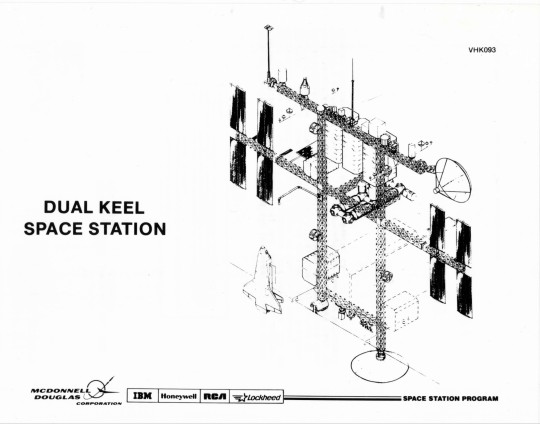

McDonnell-Douglas' redesigned 'Dual Keel' crew modules of this period introduced separate 'node modules' or docking ports which also accommodated many systems that would not have fit inside the original 'Power Tower' crew modules. NASA was still planning to contribute two laboratory modules plus two habitation modules in late 1985. Gordon Fullerton and other observers felt the Station's habitable volume was too limited when the number of US modules was reduced to one lab plus one habitation module. There would be no room for a second shower, commode or 'safe haven' emergency provisions. A Boeing longer 13.3-meter module was introduced in early 1986.

"Display model of Dual Keel Space Station concept (1986); boxy rectangular truss structure with attached modules and extended solar array wings. 1:100 Scale."
The Space Station was briefly suspended by a major row in the summer of 1986 when NASA tried to reassign some habitation module responsibilities from the Johnson Space Center to the Marshall Space Flight Center. A compromise was reached in September 1986, but it was yet another indication of the Station's Byzantine management structure and turf battles between NASA centers. But Congress still approved the project's $420-million Fiscal 1987 budget while imposing a number of restriction: power levels of at least 37.5 kW, fully outfit the microgravity lab by the sixth assembly flight, attach useful science payload by the third flight, launch all US elements before the foreign modules and restrict ESA's Columbus module to life sciences. The congressional requirements would essentially have forced NASA to change the Station along the lines of a new proposal which then, surprisingly, emerged from JSC. NASA had previously testified in Congress that no Station funds were being spent on alternative design studies. Using funding earmarked for alternate assembly sequence research, the Johnson Space Center nonetheless ordered its main contractors (Rockwell and McDonnell-Douglas) to examine a smaller, more compact configuration while keeping NASA headquarters in the dark about it... This caused additional confusion about who was really in charge of the project: NASA headquarters or Johnson.

NASA's first detailed cost assessment in February 1987 revealed the 'Dual Keel' Space Station would cost at least $14.5 billion in 1984 dollars, or $21 billion in current-year dollars. This caused a political uproar in Congress, where many politicians had started to express doubt about the project. However, NASA and Reagan Administration officials reached a compromise in March 1987 which allowed the agency to proceed with a cheaper $12.2-billion Phase One Station. This design initially omitted the $3.4-billion 'Dual Keel' structure and half of the power generators. It was dubbed 'Freedom'.
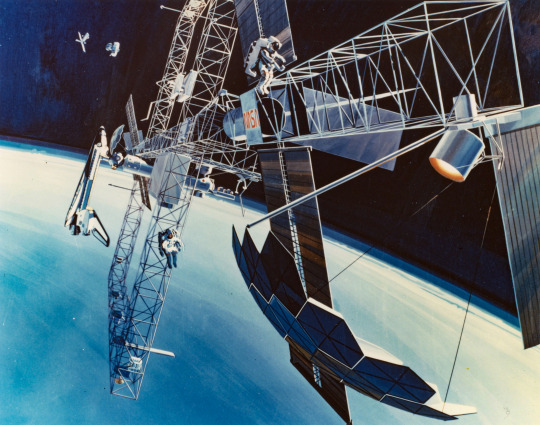

Article by Marcus Lindroos"
-Information from astronautix.com: link
Date: 1984-86
NASA ID: C-1986-2694, GPN-2003-00110, C-1985-8626, C-1985-8751, S85-42963, S87-38365, 86-H-332, KSC-85C-303, GPN-2003-00110
Mike Acs's Collection: SS23 B
National Air and Space Museum: A20100236000
NM Museum of Space History: DUAL KEEL SPACE STATION-0001, DUAL KEEL SPACE STATION-0002
SDASM Archives: 14_025378
Posted on Flickr by Numbers Station: link
#Space Station Dual Keel#Space Station Concept#Space Station Freedom#Space Station#concept art#NASA#1984#1985#1986#my post
43 notes
·
View notes
Text

Creating a Space Station
Name and Location:
Name of the space station
Orbital location (e.g., around a planet, moon, or in deep space)
Any unique features or characteristics of the location
Background and Purpose:
Brief history and reasons for the station's construction
Primary purpose or mission of the station (e.g., research, colonization, defense, trade, mining, etc.)
Key organizations or entities involved in its establishment
Design and Structure:
Overview of the station's architectural design and layout
Different modules or sections of the station (e.g., living quarters, research labs, docking bays, etc.)
Key engineering feats or technological advancements used in its construction
Size and Population:
Dimensions of the space station (length, width, height)
Estimated population and demographics (humans, aliens, robots, etc.)
Capacity for expansion and accommodating future growth
Systems and Resources:
Life support and Resource systems: Air generation and filtration, Water purification and recycling, Waste management, Artificial gravity, Temperature and air pressure control, Radiation protection, Fire suppression systems, Medical supplies and tools, Food production, Maintenance and Repair tools and facilities
Energy source and storage: Solar power, Nuclear fusion, Advanced batteries, Fusion reactors, Harvesting solar flares
Living Quarters and Facilities
Description of residential areas (individual quarters, communal spaces, recreational facilities)
Water block
Medical facilities and healthcare services available
Education and training facilities for residents and their families
Scientific Research and Laboratories
Different types of laboratories and equipment available depending on the stations’s mission
Astronomical observatories, Biological Laboratory, Climate and Environmental Studies, Planet observation and Research, Rock Analysis Facility
Transportation and Docking:
Docking bays for spacecraft and shuttle services
Transportation systems within the station (elevators, maglev trains, etc.)
Maintenance and repair facilities for visiting spacecraft
Security and Defense:
Security measures and protocols
Defense systems against potential threats: Shielding technology, Defensive satellites & space drones, Cloaking Technology, Countermeasures (flares, countershots, etc), Intruder Detection Systems, Surveillance and AI protection, Protection by AI or Hacker from outside hacks, Self-Repair System
Security personnel and their roles and ranks
Communication and Information Systems:
Communication technology used for inter-station and interstellar communication
Data storage and retrieval systems
Access to networks anddatabases
Trade and Economy:
Types of goods and resources traded on the station
Cargo of the space station
Economic systems
Currency used
Marketplaces within the station
Social and Cultural Aspects:
Societal norms and cultural diversity among the station's residents
Recreational and entertainment facilities (cinemas, sports arenas, etc.)
Events or celebrations unique to the station's culture
Governance and Administration:
Station hierarchy and governing bodies (administrators, council, etc.)
Laws and regulations specific to the station
Interactions with external governing entities (planetary governments, interstellar alliances, etc.)
Exploration and Discovery:
Expeditions or missions launched from the station
Discoveries made during exploration and sample gathering efforts
Spacecrafts and vehicles associated with the station's exploration activities
Environmental Considerations:
Measures taken to mitigate the effects of microgravity or radiation on residents' health
Environmental controls and simulations for recreating gravity and natural environments
Preservation of ecosystems and biodiversity on the station (if applicable)
Emergency Response and Crisis Management:
Protocols for handling emergencies (fires, system failures, medical emergencies, etc.)
Emergency evacuation plans and escape pods
Training programs for emergency response teams
Relations with Other Space Stations or Entities:
Collaborative projects or joint initiatives with other space stations
Trade agreements or diplomatic relations with neighboring stations or colonies
Conflict resolution mechanisms for inter-station disputes
Notable Individuals or Figures:
Prominent leaders from the station
Accomplishments and contributions of notable residents
Astronauts, scientists, or pioneers who have called the station home
Challenges and Risks:
Environmental and technological risks faced by the station
Political and social tensions within the station's community
External threats and conflicts affecting the station's stability
Future Expansion and Development:
Plans for future expansion and upgrades (where are they gonna get the resources for this?)
Integration of new technologies, scientific advancements into the station's infrastructure
Long-term goals for the station
40 notes
·
View notes
Text


| Reporting final stages of construction of the orbital ring 'Oegvann'. | Overall status of completion﹕ >>> Ring-frame Structural Integrity - 100%. >>> 'Oegvann's Orbit Similarity to Homeworld - 99.9999% >>> Atmosphere Similarity to Homeworld - 99.97% >>> Flora's Colonization of Land Surface - 95.41% >>> Homeworld's Fauna Species Reconstituted - 81.79% >>> Biosphere Integrity - 91.27% | The Collective engaged in territorial expansion during the season of Dhalamug's Sowing. Estimates predict that within the next few hibernation cycles, the entire surface of the orbital ring will be fully colonized and reach its maximum operational capacity. Next decade will allow us to construct a second Arkship using the orbital's construction decks.
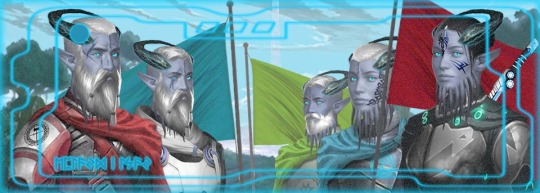
| Current orbit's arc allows for a healthy hibernation cycle to commence. Most of the Collective's members have chosen to do so on 'Oegvann', spending their final season of Oegvann's Honour in makeshift houses. Preparations for a natural hibernation have been initiated, as some chose to do so without the use of sleep-pods. Adverse effects are anticipated, with medical staff on standby to ensure a smooth transition into the next cycle.
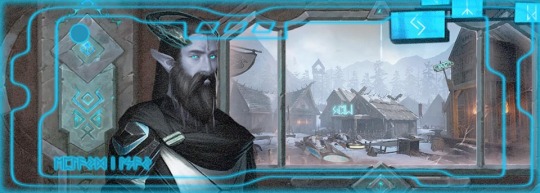
| Initializing the next phase﹕ Transition into defensive mode to guard the Collective during hibernation. | Passive observation protocols launched. | Diplomatic relations proceed as normal. | Standing by until further developments.


9 notes
·
View notes